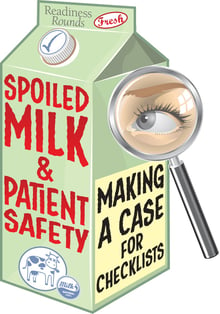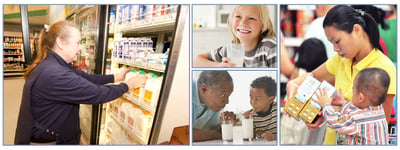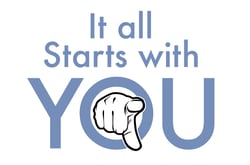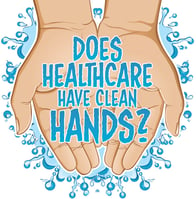
Last week in Alabama, I was training a group of nurses on how to complete checklists, and we discussed why nurses automatically check medications after removing them from the Pyxis before giving it to the patient.
Last week in Alabama, I was training a group of nurses on how to complete checklists, and we discussed why nurses automatically check medications after removing them from the Pyxis before giving it to the patient.
Of course, the reason is that we want to make sure that we are giving the patient the medication that they are ordered, amongst other things.
One of the nurses remarked that it works on the same principle as to why we always check the expiry date for milk when we go to the store – safety.
Her remark made me think about how milk could relate to patient safety and the use of checklists.

Introducing the use of proactive checklists into any facility brings about the usual array of grumblings, such as “We don’t have time to do these,” and “That’s just extra work that we have to do now.”
But is it really?
Think about the things that you do every day –not just at work, but also at home–in fact, anywhere.
Putting on the seat belt when we get into the car, locking the front door at night, checking to make sure the milk isn’t spoiled before we purchase it.
These are tasks we perform every single day, sometimes multiple times a day – but it’s just so automatic that we don’t even think about it as we’re doing it.

The same thing is true with checklists; oftentimes we are making the very same type of automatic subconscious observations when we’re at work as part of our normal everyday process.
It’s when we are asked to consciously score the results that it becomes a problem.
Why is that?
We are already running through our checklists in our head as we introduce ourselves to each patient at the beginning of our shift, evaluating lines and tubing to make sure that they are labeled and “in date”, making sure their Foley and IV caths are patent as to prevent instances of CAUTI & CLABSI, and checking that the consent forms are signed before sending them down to surgery or for a procedure.
Is recording our findings really that time consuming?
The answer is no, it is not.
What has happened is that we are adding an extra step to a process that is a subconscious habit and our conscious mind is rebelling against it.
Checklists not only allow for the cross-checking of processes by staff, but also act as a framework to ensure that critical steps are being taken, such as the evaluation of CVLs or urinary catheters from insertion to removal.
By consciously utilizing a checklist to measure and evaluate our processes during the continuum of a patient’s care, we are closing the gap that a critical item could be missed resulting in patient injury, and we are also improving processes along the way that reduce the variability of performance by staff and increasing overall patient safety.

Going back to the milk – imagine if there was a new rule handed down by the dairy industry that stated every time you bought a gallon of milk at the store and brought it home, you had to check a box before each use confirming that you looked at the expiry date and determined that the milk had not spoiled.
What if your family’s safety and health was at risk if you neglected to check the box and submit the results on a monthly basis.
Other than being a farfetched example, what would your thoughts be?
Of course you would say it was unreasonable and that you don’t have time in your day to check the box, much less submit the results; but because your family’s safety could be at risk, you would just make the time to do it, right?

Checklists are simple.
Everyone agrees that they are a good idea and make sense, but the problem is getting them completed.
They only work if they are used; and, even at that, they are only as effective as the person completing them.
The best way to combat the grumblings when a checklist is first implemented is just to DO it, do it well, and make it part of your habitual process at work.
It is the same premise as looking at the date on the milk – most people would never consider risking their family getting sick by skipping a simple check. Don’t our patients deserve the same consideration?
See our list of downloadable sample checklists here.
Previous Post: Does Healthcare Have Clean Hands?
